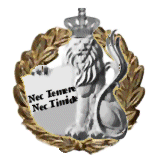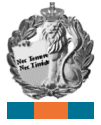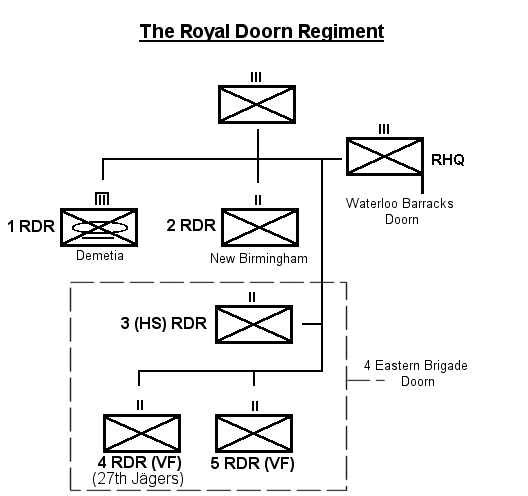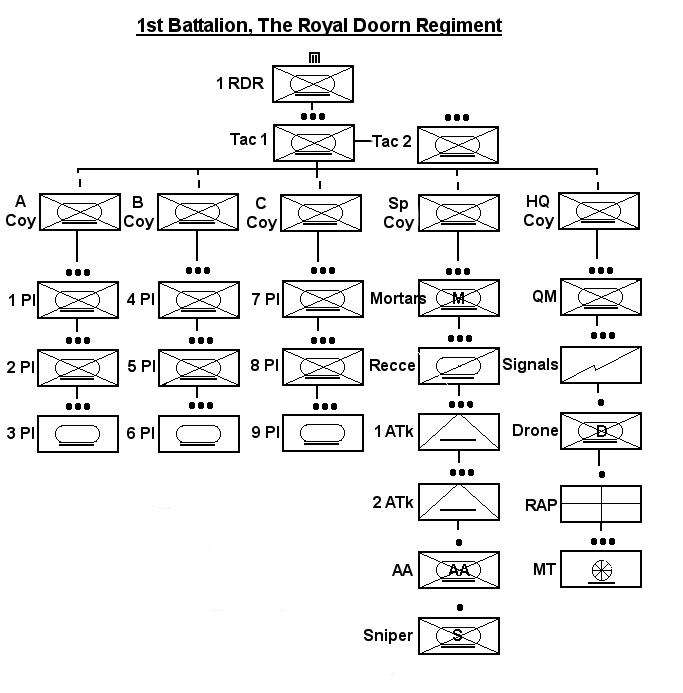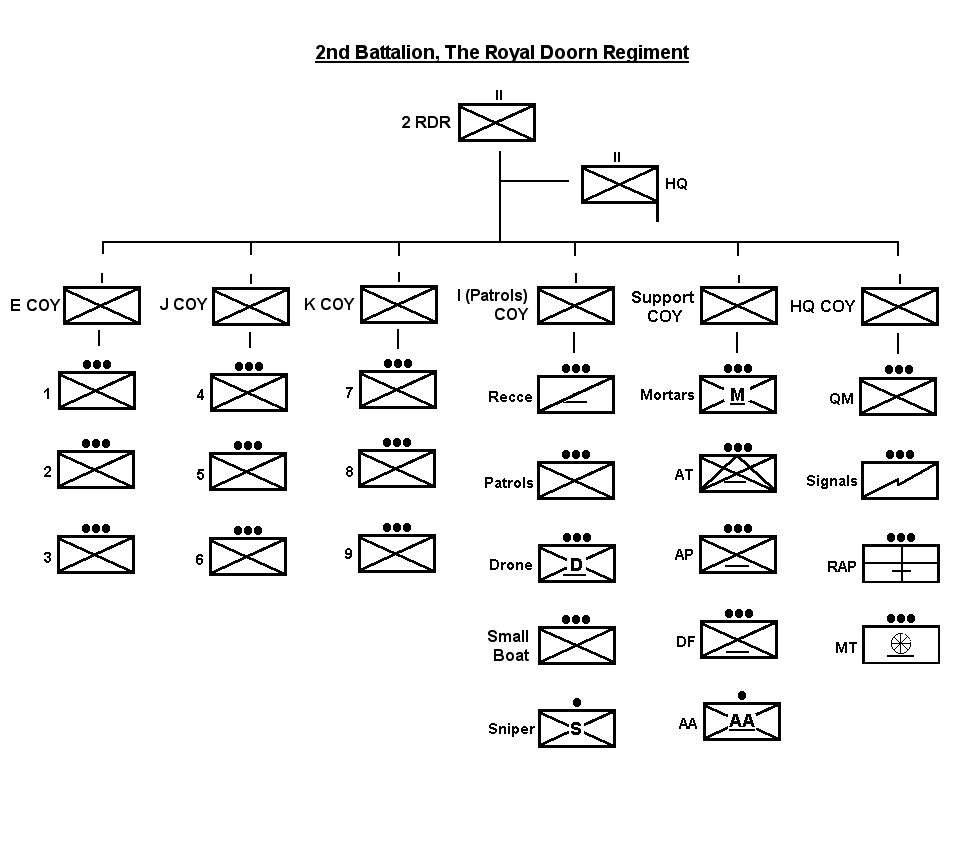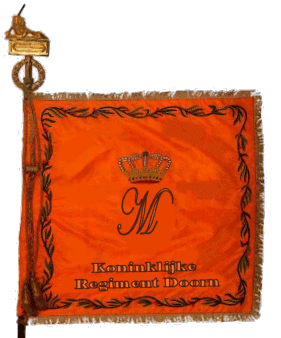Wellon Army: 2300AD
The Royal Doorn Regiment - Koninklijke Regiment Doorn Introduction The Royal Doorn Regiment (RDR) is a part of the Wellon Army's Corps of Infantry. It is recruited from the area around the Cam Valley city of Doorn in eastern New Albion. The make up of the regiment reflects the primarily Dutch and Flemish background of the people of the area and the Royal Netherlands Army was involved in the establishment of the unit in 2241 and the unit is officially bi-lingual. The RDR is organised as a typical 'New Cardwell' regiment with two regular Permanent Force battalions, one high readiness Home Service battalion and two Volunteer Force battalions. In recent years the regiment has been deployed on peacekeeping duties on Earth where it helped police the cease-fire line between France and Flanders. However the regiment has had continuing problems in recruiting up to its authorised strength. Narrative The locals we met patrolling the rubble filled southern suburbs of Brussels were initially unaware of who we actually were, lumping us in with the Brits. However as soon as we began talking to them in Dutch they soon picked up who we were and our popularity climbed. Many of the working class Flemish steadfastly refused to speak anything but their native tongue after so many years of what they saw as the 'French Occupation.' The presence of several sons and daughters of deported Flemish Resitance Army members in the ranks of the battalion further aided our rapport with the citizens. Our young soldaats from the Cam Valley had little in common with the natives of Brussels but we couldn't fail to be moved by the sights of the refugee camps and sufferings of the new state. The linguistic talents of the troops were soon appreciated and several of our NCOs were seconded to the Black Watch patrolling the notorious Hoeilaart refugee camp to aid their efforts to disarm FRA cells. However our easily formed links with the Flemish did not go unnoticed by the rump Francophone population and we were targeted by urban insurgent forces on several occasions most notably in the incident that resulted in the tragic deaths of Sergeant Groen and Private Hageman. Despite this setbacks our efforts were obviously appreciated by the British brigade commander as when we rotated back home we were replaced by our 1st Battalion. As this was one of the first peacekeeping assignments undertaken by a Wellonese battalion we had much to learn, but hopefully 2 RDR has set the standards for the units that follow us. Extract from article by Captain 'JP' in 'Soldaat' the regimental journal of the RDR
In 2209 as the result of a treaty between the British and the Netherlands governments a settlement hub was begun near the Great Loop of the River Cam in eastern New Albion. The settlement was a consequence of the Dutch realising they lacked the resources to pioneer their own exclusive colonies, but could take advantage of their relations with Britain to gain a foothold in the lucrative colonial trade. The Netherlands invested heavily in the development of the new city and a majority of the new colonists were from that country, although many British and Wellonese citizens were also present. Following these were other citizens from northern Europe, including Westphalians, Hanoverians and Danes. Although not the most numerically significant many Flemish citizens of France's Belgian Departement also emigrated to the newly established area. With the Flemish beginning to chafe under French rule the discontented Flemish had a cultural influence beyond their numbers in the area, a factor which was maintained through the years. Doorn was placed with care in a prime location to benefit from the burgeoning river trade along the Cam whilst being in an area of considerable agricultural potential. As the city was established it gained a police force and the beginnings of a territorial militia which would be tasked primarily with supporting the police in times of trouble and supporting the civil authority. These were trained by a mixed team of British and Netherlands military personnel. In 2241 the Dominion of Wellon was formed and with it the Wellon Defence Force which included units of the former Territorial Defence Forces. It was decided that these units would be expanded with the creation of additional regular units and consequently a regiment was to formed in Doorn. The 1st Battalion of the Doorn Regiment was formed from members of the militia who volunteered for regular service and was reinforced by local recruits and had a leadership cadre recruited mainly from seconded Dutch personnel as existing Wellon and British sources were already stretched. Consequently the Doorn regiment maintained a distinct Dutch flavour from the start, and had a visual distinctiveness in the 'Danish' side cap introduced by the first CO in emulation of his old regiment, the 'Gele Rijders'. However the battalion got off to a slow start, with recruiting poor due to the economic boom the region was then undergoing. To rectify this the battalion strongly recruited newly arrived colonists who had failed to get on their feet. Although they included many Anglo-Dutch a substantial number from areas linked to the former Dutch colonial empire also joined in addition to an increasing number of Flemish recruits. As the regiment slowly grew it established an RHQ in the Nederbay area of Doorn on a spur jutting out into the Cam. Whereas other regiments developed imposing bases Waterloo Barracks was less intimidating with woodlands and gardens being dotted around the base. The unit quickly developed its capacity for riverine operations, building on work already done by the militia units of the area. This entirely sensible idea was developed partly to adapt to local conditions and partly to build up a distinctive esprit and tradition of riverine soldiering within the unit. In 2249 the Doorn Regiment deployed on its first tour of the Southern Archipelago, where it put its skills in small boat handling to good use. However some aspects of their training were less impressive as the rates of sickness in the unit were considered too high and a sign of lax discipline whilst their jungle skills were regarded with disdain by local units. The battalion returned three years later and had a much more satisfactory experience, and would go on to complete five more tours in the area. Over the years the regiment grew and consolidated. The 1st Battalion reached full strength and an independent company was formed for support of the Doorn Metropolitan Police for search and rescue operations in the nearby area and the RHQ grew to a respectable size. Links with local militia units were nurtured and proved a fruitful recruitment tool for the Doorn Regiment. In 2277 the Dominion of Wellon became the Commonwealth of Wellon and gained full home rule from Britain. Doorn was a special case due to its links with the Netherlands but it too became fully self-governing. In recognition of the links between the two the Queen of the Netherlands bestowed several Royal Warrants on institutions in the area. Amongst these was the Doorn Regiment, which became the Royal Doorn Regiment (or to Dutch speakers the Koninklijke Regiment Doorn) in the autumn of 2277. In 2285 the 'New Cardwell' reforms took place and the Royal Doorn Regiment was reorganised. A second regular, Permanent Force, battalion was to be raised as was a Home Service battalion. In addition local militia forces were to be integrated into the regimental structure, something resented especially in the socially prestigious 27th Jägers. The formation of the 3rd (Home Service) Battalion was relatively easily accomplished drawing on the resources of D (Independent) Company, RHQ and the militia battalions. However the regular side of the unit had more trouble forming its 2nd Battalion. Several key high flying NCOs and officers from the 1st Battalion were posted to the second battalion and these were reinforced by officers on secondment from the Royal Netherlands Army. However the level of manpower available was insufficient to man two battalions, and as the 1st Battalion was in a higher readiness role it had to take precedence over its sister unit with the low priority mechanised role. Recruiting programmes were relatively unsuccessful as Doorn was once again in an economic upturn, indeed at one stage a move towards local conscription was mooted in the Doorn Council. Eventually recruiting looked further afield, with the river trade hit by unemployment through the introduction of new technology Rivermen were targeted by the regiment (along with most Cam Valley units) and produced a good crop of soldiers. More surprisingly many potential recruits arrived from the republican communities in Riverside, who had no desire to serve in units linked to the British crown but less compunction about one linked to that of the Dutch. Despite all of these measures it was generally accepted that the RDR could provide manning for only 75% of its authorised PF strength. As a result the battalion with the higher priority was maintained at full strength and the other battalion at lower strengths and if mobilised would have to be brought up to strength with reservists or volunteers from the HS and VF battalions. Consequently the possibility of reducing the RDR to one PF battalion has been mooted in the Defence Council, but not so far implemented. The RDR was strongly effected by the War of German Reunification and the War of Flemish Independence on Earth as many members of the regiment had relatives in Germany, France and the Netherlands. Indeed as many as 50 former RDR soldaats fought in the war, most with the Flemish Resistance Army and Bundeswehr, but a handful with ad-hoc Légion Étrangère units in French ranks. When the campaign in Belgium ended in the creation of a new independent state of Flanders the need for a peacekeeping force to police the borders and contain inter-ethnic clashes became swiftly evident. Led by Australian and including strong contingents from Britain, Canada and others the force was soon in place. Wellon offered to participate and the offer was swiftly accepted. The unit chosen was 2 RDR, then serving with the 2 Light Brigade and trained for intervention and peacekeeping duties. The unit mobilised quickly, fulfilling equipment and manpower shortfalls from 1 and 3 RDR, and transported in HMS Hollis its lead elements were on the ground two weeks later. Assigned to the British 3rd Light Brigade patrolling the 'hot' southern sector of Brussels the soldaats quickly made their mark. Showing commendable professionalism and an easy rapport with the local populace 2 RDR became an indispensable part of the brigade. However towards the end of 2 RDR's tour the unit was targeted on several occasions by Walloon militias, and two members of the battalion were killed in a car bombing. Later K Company was involved in a serious firefight after being called in to contain rioting in a Walloon refugee camp, the consequent reaction by the brigade led to a significant diminution of Walloon insurgent activity in the area. At the end of their six month tour it was decided to continue with the Wellonese contribution and, somewhat controversially, 1 RDR was chosen for the task. 1 RDR could only muster its HQ, support and two rifle companies and was reinforced by D Company, 3 RDR and A Coy, 1 NCLI. Their tour continued in the same vein as 2 RDR's, with patrolling and riot control high on the agenda until replaced by the 2nd Royal Victoria Rifles, the last Wellonese unit to serve in Flanders. Since its tour in Flanders the RDR has not yet been called upon for further operations, although like all Wellonese Army units the increased tension caused by the Kafer War has led to stepping up of operational readiness. As the RDR's manpower problem remains it has introduced a High Readiness Volunteer system to rapidly reinforce its PF battalions with VF soldiers, these scheme has proved successful so far and may be copied in other units of the Wellon Army. The Royal Doorn Regiment recruits most of its soldiers from the City of Doorn and the area of the Great Loop and the Mid-Cam Valley. The bulk of its soldiers are those descended from the original settlers of Doorn, primarily of Netherlands citizens including those of Dutch, Surinamese, German and Indonesian descent, but also including other North Europeans. However PF recruitment from these sources has always been relatively poor in terms of the proportion of the population with enlistment more common amongst the more impoverished and marginalised parts of the community. RDR's persistent manpower problems have resulted in them looking further afield for recruits. The Cam Valley remains the centre of these efforts and for a time those communities who earned their livelihoods in the river trade were targeted. The introduction of new shipping and equipment reduced the need for the highly skilled pilots and threw many communities of Rivermen into dire straits. Many went for soldiers or to the Navy, and although the RDR was relatively slow in recruiting Rivermen they soon managed to play on the regiment's small boat skills to attract a significant number. Today several Rivermen towns along the Cam Valley have a tradition of sending some of their sons and daughters to the RDR and they remain the back bone of the boat crews and Jägers. The RDR also recruits in the city of Riverside far down the Cam. Although normally the recruiting area for the Loyal and Royal Wellon Regiments, the RDR have carved a niche in the working class republican heartland's of the city. Consequently some 30% of the regiment's recruits come from this area which has somewhat altered the culture of the regiment, in particular many of the regiment's Senior NCOs are Riversiders. Some believe that a stronger campaign in Riverside could bring the regiment up to strength but so far the RHQ has balked from such a measure. Further afield the regiment runs a recruitment campaign across Wellon targeting the more dispersed Netherlands community although it has relatively little success. The regiment has a strong exchange scheme with the Royal Netherlands Army that goes beyond the scale of similar arrangements in other Wellonese regiments, indeed over 30 Dutch soldiers and officers will be serving with the regiment at most times. These are often enticed to remain in the regiment by means of easing the individual's Wellonese citizenship application. The RDR's officers are usually drawn from across the regiment, although with a larger proportion of those of Dutch descent than are found in the ranks. Those of Flemish and Surinamese descent are also strongly represented. Rivermen have begun to make their mark but Riversiders are almost completely under-represented except for several commissioned ex-SNCOs. For the majority of RDR recruits Phase 1 training is undertaken at Waterloo Barracks in Doorn, although the PF recruits from Riverside are trained at Warsaw Barracks in New Shorncliffe. In recent years the RHQ has tried to get all RDR recruits trained initially at Doorn, but so far this has not come to pass due to opposition in the WMoD. As a result there is already something of a split between recruits from Doorn and those from Riverside before Phase 2 starts. Phase 2 training is conducted at the Governor General's Infantry Training Centre at Alma Barracks in New Shorncliffe. There the recruits for the RDR are mixed in with others from across Eastern New Albion for six months of infantry training, including long periods in the field out in the Eastern Training Area. On completion of Phase 2 all PF recruits are then temporarily assigned to 3 RDR and return to Waterloo Barracks. The regiment has no formal Phase 3, instead the newly qualified soldiers are held administratively with 3 RDR whilst they undertake a variety of courses. Those going to 2 RDR must attended and pass the Para Battle Cadre for example, and build-up training is conducted until a course becomes available. In addition other weapons or trade courses can be undertaken during this period. Once the soldaat is deemed to be qualified to move to a line battalion he is then transferred out of 3 RDR. For fully trained soldiers 3 RDR runs a number of specialist courses. Most well known of these is the Small Boat Course, which trains soldiers to handle small boats and ACVs on the river. The SBC has been heavily influenced by the Rivermen in the ranks of the regiment and is now very highly regarded by other units with RWE, RWN and other personnel being sent to the course. Although most SBC qualified soldaats are consolidated in 3 RDR all the other units have a cadre of these troops should they be needed, especially during tours in the Southern Archipelago. Another 3 RDR course is the Jäger Course, little known outside the regiment but highly regarded within it. Open to all ranks of the RDR, the Jäger Course is 12 weeks long and trains the student in survival, small boat (although not to SBC standards), raiding, reconnaissance, tracking and hunting skills. It has evolved from a training package originally given to D (Independent) Company so it could back up local authorities in search and rescue missions. Today it is more of a specialist military skills course, and success on it, with the award of the Jäger flash, marks out the soldaat for the rest of his career. The course is intensive and with only two courses a year each with 20 students it is fairly exclusive. Jäger trained personnel are most frequently found in the recce platoons but can be found throughout the regiment. Some non-RDR personnel, usually from local units of 52 RWA or 31 RWE, have taken the course but RDR personnel have priority. The RDR allows its officer candidates to go on to RMANC relatively quickly, sometimes only a month after passing out from GGITC. However they must undertake and pass a two week Junior Leader Cadre at Waterloo Barracks. This cadre is also undertaken by those potential Corporals going to the Junior Wing of RMANC. RDR takes its links with other armies seriously and has exchanges with the Royal Greys, Coastal Jägers of the Freiwehr and of course with the Royal Netherlands Army. Opportunities for training with these units are frequent and many RDR personnel have foreign qualifications. In recent years the RDR has started exchanges with the Flemish Army and has frequently sent small unit training teams to Earth.
1st Battalion, The Royal Doorn Regiment 1 RDR is a regular Permanent Force unit, first formed in 2241 and is currently a mechanised infantry battalion assigned to 3 Mechanised Brigade in the newly organised 14 Mechanised Division. However 3 Mech Bde remains in its historic location at Demetia to the west of Quinnell. It includes three manoeuvre companies; A, B and C and with HQ and Support Companies and is a combined arms formation down to the company level and is equipped with the Dragoon AFV. Currently 1 RDR is very understrength, with only 55% of its authorised personnel. As a result it keeps A Company fully manned and up to strength whilst B and C Companies are at cadre strength, with AFV crew and leadership positions mostly filled but woefully understrength in riflemen. The battalion will transition to the armoured role at the end of 2303.
2nd Battalion, The Royal Doorn Regiment 2 RDR is the regiment's other PF battalion and is assigned as a light role battalion to 2 Light Brigade in the Wellon Light Division and based at the New Birmingham Cantonment. Formed in 2285 it languished due to the lack of manpower until 2291 when it took over the light role from 1 RDR. A great number of troops transferred in from 1 RDR to bring the unit up to full strength, and it was in this state that the battalion was sent to Earth to operate in the Flanders peacekeeping force. Since its return it has remained in this role, undertaking a further 2 tours in the Southern Archipelago, and it is regarded as an well trained and solid light role battalion. However it will begin to transition to the mechanised role at the end of 2303, and it is expected most of its personnel will transfer to 1 RDR. The battalion is composed of four rifle companies (E, I, J and K, with I Coy dedicated to recce tasks) a Support Company and a HQ Company. The battalion has at its disposal an array of vehicles and methods of transport that can be called upon depending on the conditions which it may have to face. The main ACV is the WMV Reynard III, a robust long ranged tactical transport, for other occasions the light Quad prime mover can be utilised. One change of organisation is the addition of the Small Boat Platoon in India (Patrols) Company which provides the battalion with specialist boat support. However the SB Platoon operates with heavily armed ACVs in support of the rest of I Coy should their boats not be required. The battalion does not have Combat Walker Platoon as it would not have time to form one properly before converting. |
